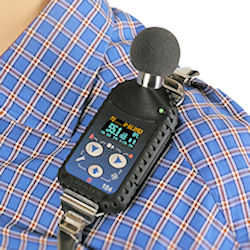Work-shift Sampling
When the results of the noise survey indicate that noise levels may exceed those listed in 1910.95, additional monitoring using dosimeters is necessary.
Establish a sampling protocol for your workplace. You can follow this sampling protocol:
- Explain the purpose of the dosimeter to each employee being sampled and emphasize that the dosimeter is not a speech recording device.
- Inform the employee being monitored that the dosimeter should be placed so that it does not interfere with work, and emphasize that the employee should continue to work as usual.
TSI Quest The Edge Dosimeter
- Instruct the employee being sampled not to remove the dosimeter unless absolutely necessary and not to cover the microphone with a coat or outer garment or move it from its installed position. Inform the employee when and where the dosimeter will be removed.
- Place the microphone in the employee's hearing zone. OSHA defines the hearing zone as a sphere with a two-foot diameter surrounding the head. Most manufacturers recommend that the microphone be placed on the shoulder area midway between the head and the point of the shoulder. Practicality and safety will dictate the actual microphone placement at each survey location.
- Use the microphone windscreen to protect the microphone when the wearer is outdoors or in dusty or dirty areas (the windscreen will not protect the microphone from rain or extreme humidity).
- When noise levels are different at each of the employee's ears, the higher level must be sampled.
- Position and secure any excess microphone cable to avoid snagging or inconvenience to the employee. If practical, the cord should be run under the employee's shirt or coat.
- Check the dosimeter periodically to ensure the microphone is properly oriented.
- Obtain and note sound level meter readings during different phases of work the employee performs during the shift. It is important to take enough readings to identify task work cycles. For statistical reasons, more readings should be taken when noise levels fluctuate widely.
- Record the information required on the OSHA-92 Noise Survey Report.
Knowledge Check Choose the best answer for the question.
2-7. Which instrument is used to conduct additional monitoring when the noise survey indicates noise levels may exceed those listed in 1910.95?
You forgot to answer the question!

